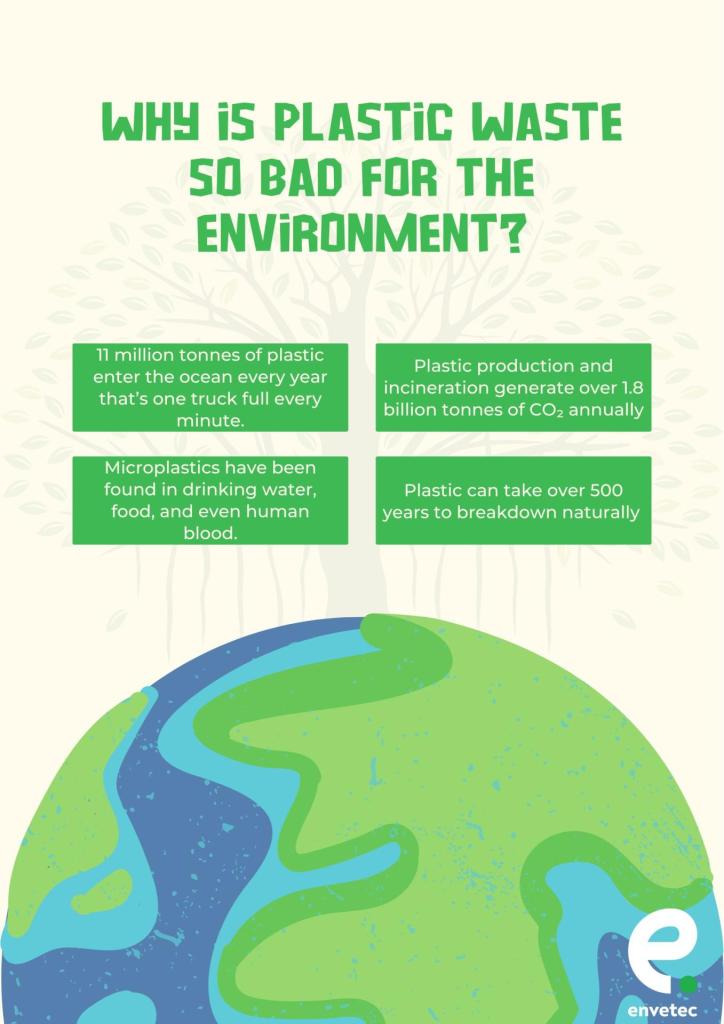Envetec Insight
World Earth Day
What Exactly is the Problem With Plastic?
Given that it’s World Earth Day, we wanted to take a broader look at a problem that a lot of people are aware of but not a lot of people fully explore … Plastic waste.
It’s everywhere. And while most people know that plastic is “bad for the environment”, very few can explain why. The truth is, the environmental impact of plastic waste goes far beyond litter on beaches or bottles in the ocean. It’s a complex, global issue that affects the climate, ecosystems and even human health.

Why is Plastic Waste a Problem? A Deeper Dive
1. Plastic Is a Long Term Commitment
One of the biggest problems with plastic is its durability. Plastic is hailed for its durability and stability, it’s designed to last and unfortunately, it does. Most plastic items take hundreds of years to break down. But even then, they don’t fully biodegrade. They simply fragment into microplastics which are tiny particles that persist in the environment, where they can be ingested by wildlife and even enter the human food chain.
2. Plastics Leach Chemicals
Many plastics contain additives such as flame retardants, plasticisers, or stabilisers that can leach out into the environment over time. Some of these substances are known to be endocrine disruptors or carcinogens, posing severe long term risks to ecosystems, water sources and human health.
3. The Carbon Problem: How Plastic Production Impacts Climate Change
Plastics are made from fossil fuels, meaning the production, transport, and disposal of plastic products all contribute heavily to global greenhouse gas emissions. A report issued by Beyond Plastics found that if plastic were a country, it would be the fifth largest emitter of greenhouse gases in the world. Even methods that “reclaim” some of carbons impact such as “waste-to-energy” just shift the problem, once burned the carbon and pollutants trapped in plastic material are released into the atmosphere.
4. Wildlife Gets Caught in the Crossfire: The Devastating Effects of Plastic Pollution
Plastic pollution is a death trap for marine and terrestrial animals. Birds, turtles, fish, and even livestock can become entangled in plastic or mistake it for food. This can lead to injury, starvation, or suffocation. Studies estimate that over a million marine animals die each year due to plastic waste.
5. Beyond the Bin: Understanding the Challenges of Waste Recycling
There is a common stat that is quoted which states that “only 10% of plastic is recycled” and while this number is stark, the solution to this issue can be found in the analysis of the problem. Recycling rates aren’t just low because the infrastructure isn’t there … It’s also a human issue or as our manufacturing would call it “user error”. Some common reasons plastics aren’t recycled are:
- People often assume a product can’t be recycled so they don’t look for a solution.
- Contaminated or specialised plastics are written off as waste far too quickly, as they are considered a complication.
- Segregation is treated as a burden instead of a basic responsibility.
Addressing these attitudes matter. Because when effort is made to separate and treat waste properly, new possibilities emerge.
Envetec: Innovating in Biohazardous Waste Treatment and Recycling
At Envetec, we see this often. Our GENERATIONS technology enables the recycling of biohazardous plastics that were once destined for landfill and/or incineration. Many times when we have initial discussions with clients and we ask them about the content of their lab bin they have no idea. This is because before the innovation that came with GENERATIONS this material was destined for destruction and landfill, so why would a lab manager or CSO bother trying to understand that waste? However, once companies become aware of an existing solution for this material such as ours and reach out you often see a radical change in how they view what goes in their lab bins.
This is a reminder that innovation alone isn’t enough, for positive change to be implemented mindset, policy, and willingness are required to drive progress.
What Can We Do to Improve Waste Treatment Processes?
World Earth Day is about awareness, but also action. Solutions to the plastic waste crisis need to be systemic:
- Reduce reliance on single-use plastics
- Rethink how plastic is produced and consumed
- Innovate with sustainable alternatives and technologies
- Support circular economy models that give plastic a second life

Final Thought: Rethinking Our Relationship with Plastic
This Earth Day, it’s worth remembering: plastic itself isn’t the enemy, how we use it is. If we’re willing to rethink what’s possible, we’ll find that much more can be changed than we once believed.